

Latino Persistence in Education: Finding a Balance
The number of Latinos in higher education is increasing. However, Latinos are the least educated ethnic group in terms of bachelor’s degree completion with only 16 percent attaining a bachelor’s degree or higher.
According to Dr. Linda Castillo’s research, part of the problem may stem from intragroup marginalization. In other words, being teased by family members for not being Latino enough can impact a student’s motivation to continue in college.
Dr. Castillo, professor of counseling psychology, and her research team knew the importance of addressing this because of their own experiences in the education pipeline. Dr. Castillo had many instances where she was treated differently by white students and faculty for being Latino, but it was not until she was in college that she noticed her family’s views start to change. They treated her differently because of the way she spoke and for not being Latino enough…
Link to article
Latino Leader Named Head Of City Colleges Of Chicago
In the midst of a controversial overhaul, a Latino community leader has been tapped to take the helm of the City Colleges of Chicago.
Juan Salgado will replace Cheryl Hyman, a former corporate executive, as the head of the state’s largest community college network
Chicago Mayor Rahm Emanuel praised Hyman for improving the City Colleges’ graduation rate and consolidating programs with a focus on linking them to jobs under a plan called Reinvention. She also raised tuition and created a tuition structure that favored full-time students over those taking classes part time.
Those moves were sharply criticized by faculty and some community groups as a top-down initiative that they said limited student access…
Link to article
Helping ‘At-Promise’ Students Succeed
UCSB sociologist Victor Rios to discuss how emotional support from authority figures impacts the lives of marginalized students
UCSB sociology professor Victor Rios is among four presenters in PBS series of TED Talks on innovative approaches to education
Research on students who overcome adversity to successfully navigate higher education has shown that emotionally relevant educators often make the difference, by fostering the resilience that makes success possible. No one knows that better than Victor Rios, whose own life was forever altered by a high school teacher who saw his potential and became his mentor…
Link to article
Hispanic Latino Affairs launches mentorship program
A new UF mentorship program is helping Hispanic and Latino freshmen adjust to college life.
The Latino Educational Advancement Program, started by Hispanic Latino Affairs this Spring, is a five-week program that aims to help freshmen succeed in college classes and get involved on campus, said Carissa Cullum, the coordinator for LEAP. The program began Friday when the first 20 mentees and 10 mentors introduced themselves in the Multicultural and Diversity Affairs suite.
Cullum, a 24-year-old UF Latin American studies graduate student, said the program will host workshops every Tuesday starting this week. The workshops will teach students about on-campus resources, study tips, scholarship opportunities and Hispanic and Latino inclusion in higher education, she said…
Link to article
MABPA: Mexican American Business and Professional Association
Mission
MABPA: Prioritizing access, advocacy and prosperity for all San Diego Communities.
MABPA’s robust membership actualizes its mission with an informed focus on Business, Education, Community Leadership, and the Legislative domain…
Link to web site
New Mexico State University highlighted on list of Top 100 Colleges and Universities for Hispanics
According to the Top 100 Colleges and Universities for Hispanics list in the August 2016 edition of The Hispanic Outlook in Higher Education magazine, New Mexico State University has been recognized as one of the best institutions for Hispanics in the country.
Two women walk down the sidewalk.
This fall, the Hispanic Outlook in Higher Education magazine ranked New Mexico State University as a top institution for Hispanics in the nation. (NMSU photo by Darren Phillips)
Using data from the Department of Education (2014), NMSU ranked in the top 30 in both first major bachelor’s degrees granted (26th) and first major master’s degrees granted (21st). NMSU awarded 1,302 bachelor’s degrees (48 percent) to Hispanics, and 305 Hispanic students (38 percent) were awarded master’s degrees…
Link to article
An Honor of Note
Francisco Lomelí had no idea he was being considered for membership in a prestigious organization of Spanish language scholars. And then out of the blue word came that he was in. A professor of Spanish and Portuguese and of Chicana and Chicano studies at UC Santa Barbara, Lomelí was elected as a correspondent to the North American Academy of the Spanish Language. The honor is given to a small number of scholars who have distinguished themselves in their fields. Known by its Spanish acronym ANLE, the academy…
Link to article
A Degree in Every Home
Jacki and Gilbert Cisneros, founders of educational outreach program Generation 1st Degree, bring Pico Rivera high schoolers and their parents to UCSB for a day of tours and talks…
Link to article
Developing Hispanic-Serving Institutions Program – Title V
The Developing Hispanic-Serving Institutions (DHSI) Program provides grants to assist HSIs to expand educational opportunities for, and improve the attainment of, Hispanic students. These grants also enable HSIs to expand and enhance their academic offerings, program quality, and institutional stability
Applicant Information
Institutions must be designated as an eligible institution of higher education in order to apply for the Title V program and must meet the program-specific requirements to be defined as an HSI.
To be designated as an eligible institution of higher education, an institution must apply for and receive designation through an application process. Please refer to the most recent Application for Designation as an Eligible Institution. You may contact the program office if you have questions regarding eligibility….
Link to announcement
Mexican American Proarchive: Annual Report on Mexican American Professionals
News from the census American Community Survey is generally good for the 2015 year. Mexican American college enrollment was up from 18.7% to 18.9% in the 2014 and 2015 years. Graduate or professional degree attainment was also up from 2.9% to 3.0%. The number of bachelor’s degrees granted to Mexican American students rose from 7.6% in 2014 to 7.8% in 2015.


In spite of these gains, Mexican Americans still remain at the bottom of the ladder when it comes to earning a bachelor’s degree. Even after broadening the group to Latinos or Hispanics, this group still lags behind. According to the Pew Hispanic Center: “As of 2014, among Hispanics ages 25 to 29, just 15% of Hispanics have a bachelor’s degree or higher. By comparison, among the same age group, about 41% of whites have a bachelor’s degree or higher (as do 22% of blacks and 63% of Asians).” Pew reports that the main reasons for this low graduation rate is that Hispanics are less likely “to enroll in a four-year college, attend an academically selective college and enroll full-time.”
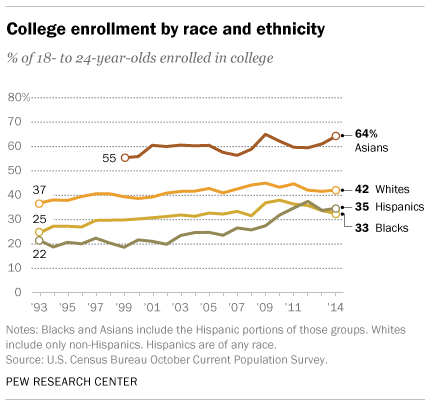
Also in the good news column, the University of California will continue to push for a greater number of underrepresented minorities; namely, Chicano/Latino students whose resident freshmen numbers rose from 2.7% to 32.3% of admitted California freshmen. In other good news, the proportion of Chicano/Latino students transferring from community colleges increased to 29.3% from 26.8% for 2015.
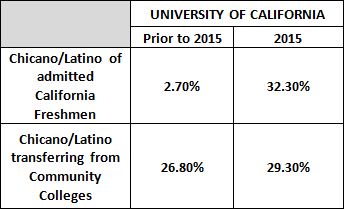
Occupations, including those in management, business, science, and art, fared better for Mexican Americans. The number of Mexican Americans filling these occupations rose from 17.4% in 2014 to 17.5% in 2015.

The total number of Hispanics filling these occupations was 16.1% in 2015, a bit lower than Mexican Americans specifically.
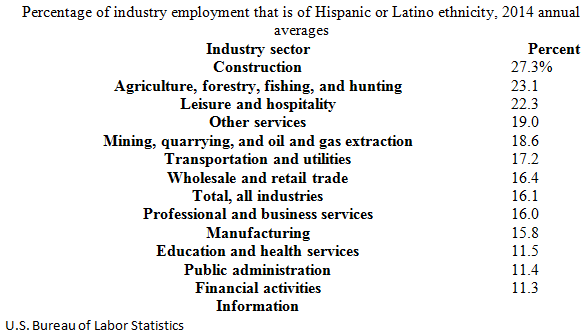
The report shows that industrial employment for Mexican Americans remained the same for 2014 and 2015 at 10.2%.
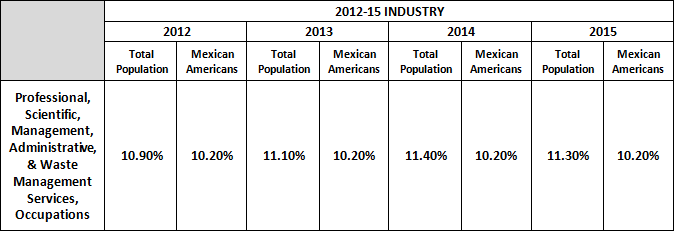
The figures for Hispanic or Latino employment for 2015 and 2016 show a healthy increase.
According to the Pew Hispanic center, “Construction, professional and business services, health services, financial services and food services…showed healthy gains.” Most of the jobs gained by native-born Hispanic workers were in manufacturing, mostly durable goods (82,000 Hispanic workers in this industry), followed by wholesale and retail trade (79,000), publishing, broadcasting, communication and information services (55,000), and construction (54,000).
Foreign-born Hispanics had the most job gains in construction (417,000), followed by business and professional services (179,000). Together, those two industries accounted for almost three-quarters (74%) of all jobs gained by foreign-born Latinos between 2005 and 2006.
The business and professional services sector, which ranges from management and technical services to janitorial, landscaping, and waste management services, is also a key employer for non-Hispanic workers. Of the total increase in employment in 2005-06, non-Hispanic workers accounted for 410,000 employees in the industry, native-born workers 327,000, and foreign-born workers 83,000.
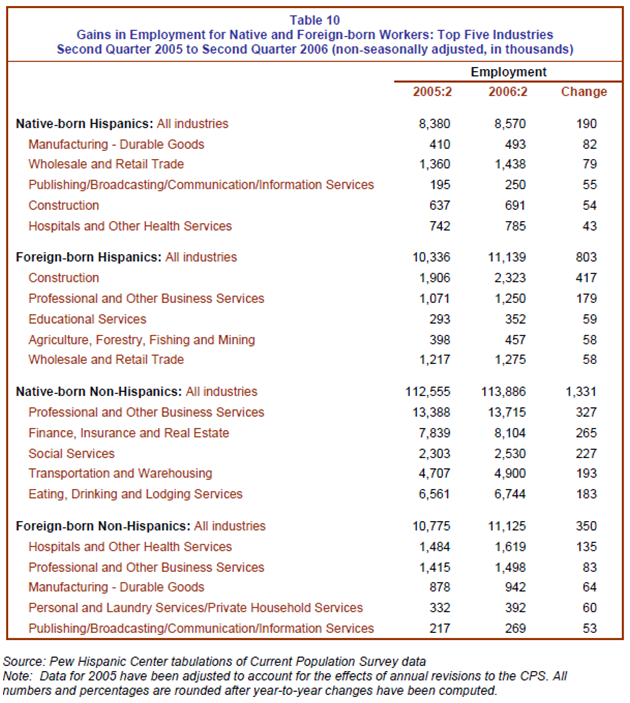
Sources
- Census Bureau, Selected Population Profile in the United States: 2015
- Pew Research Center
- University of California
- Bureau of Labor Statistics
USC professor spotlights the significance of Latinos to California’s future
The USC Price School of Public Policy has taken a leading role in training local decision-makers and its partnership with the Latino Caucus demonstrates the inroads it has made.
That’s a thought from USC Price Professor Raphael Bostic.
USC Price hosted more than 20 public officials from the League of California Cities Latino Caucus, who took part in the Bedrosian Center on Governance’s Local Leaders Executive Education Forum on Sept. 22 and 23.
The participants, many of whom are mayors or council members of cities across California, heard presentations from USC Price faculty on leadership, public ethics and housing policy, among other topics.
Professor Frank Zerunyan, director of executive education at the Bedrosian Center, led the program, which was the product of an agreement that USC Price and the Bedrosian Center signed with the Latino Caucus in 2014 to provide training aimed at enhancing the leadership capacity of public officials statewide…
Link to article
NMSU observes National Hispanic-Serving Institution Week, Elba Serrano to speak
LAS CRUCES — New Mexico State University joins the nation in celebrating National Hispanic-Serving Institution Week Sept. 12-18.
NMSU Regents Professor Elba Serrano is the keynote speaker Sept. 14 at 4 p.m. at Domenici Hall in the Yates Theater. Serrano will talk about the importance of NMSU’s HSI designation and how it positively impacts research funding. The event is open to the public…
Link to article
Center for Mexican-American studies welcomes new director
The College of Liberal Arts’ UT Center for Mexican American Studies has selected professor John Morán González as its new director.
González previously had a courtesy appointment with the Department of Mexican American and Latina/o Studies. He teaches courses in Latina/o cultural studies, Mexican American literature and late 19th-century U.S. literature. He has published in journals such as American Literature, Aztlán and Nineteenth-Century Contexts. González also edited The Cambridge Companion to Latina/o American Literature, published in 2016. This publication is the first critical reference anthology devoted to Latin literature…
Link to article
Nationally Recognized Scholar of Latino Politics to Speak at CSU, Chico for Constitution Day 2016
Dr. Gary Segura of Stanford University will make the California State University, Chico Constitution Day keynote address, “The Future is Ours: How Demographic Change and Latino Voters Are Changing American Politics in 2016 and Beyond.” The event is on Tuesday, September 20 at 6 p.m. in the Bell Memorial Union auditorium. It is a free, public event open to all students, faculty and community members.
Gary Segura is the Morris M. Doyle Centennial Professor of Public Policy at Stanford University. He is the director of the Stanford Institute on the Politics of Inequality, Race and Ethnicity, and a fellow of the American Academy of Arts and Sciences. His work focuses on issues of political representation and social cleavages, the domestic politics of wartime public opinion, and the politics of America’s growing Latino population…
Link to article
California school test scores: Amid gains in English and math, ethnic gap widens
California students’ scores in English and math rose from last year to this spring, with gains spanning gender, race, language and socioeconomic differences, test results released Wednesday show.
However, the encouraging news in the annual state test scores was tempered by a harsh reality: Overall, fewer than half of students statewide — 49 percent in English and just 37 percent in math — scored proficient.
And alarmingly, the wide gap in performance between Asian and white students on one hand and black and Latino students on the other remains unrelenting, despite years of focused efforts and a recent infusion of state funds to close it…
Link to article
Retooling the Ph.D.
For generations, the path of a doctoral candidate in the humanities has been clear: collect your sheepskin and go directly to academia. But a tight job market for those graduates is leading universities across the country to rethink that model. Now, a grant from the National Endowment for the Humanities (NEH) will help UC Santa Barbara explore ways to create new post-doctorate options for its humanities students…
Link to article
PolitiFact: Pell Grants helping half of Latino students
Posted: 12:00 a.m. Sunday, Aug. 14, 2016
Proposed education appropriations legislation from the Republican-controlled U.S. House would cut Pell Grant funding next year by $1.3 billion.
Despite the overall funding cut, Pell Grant maximum amounts are due to rise in the 2016-17 award year to $5,815 from $5,775. Pell Grants, started by Congress in 1972, are awarded to financially needy students who haven’t yet earned a bachelor’s or professional degree.
The proposed funding “cut” is because some — such as U.S. Rep. Tom Cole, R-Okla., who chairs the House subcommittee that drafted the legislation — says the Pell Grant program has been running a surplus for years and that money would be better spent elsewhere…
Link to article
Reyes appointed director of Southwest Hispanic Research Institute
Bárbara Reyes has been appointed director of the UNM Southwest Hispanic Research Institute (SHRI). Reyes, an associate professor of History, has research interests that include Chicano History, Southwest History, U.S. Immigration History, Gender and Comparative Women’s History, Race, Ethnicity, Cultural Studies. For additional information about her research visit her faculty website.
Reyes has served as interim director of SHRI for the last two years. Earlier this year, the Office of the Vice President for Research (OVPR) coordinated an internal, competitive search process with SHRI faculty affiliates. In consultation with the search committee and with feedback from SHRI stakeholders, Reyes was selected as director. She began her two-year term on July 1, 2016…
Link to article
Visiting artists celebrate Mexican heritage in West Chicago
Mexican artist Juan Chawuk works with teens from the West Chicago Library’s young adult council on a mobile mural that spells out the words “West Chicago.” Chawuk is one of two artists who were invited to take part in People Made Visible’s artist residency program this summer…
Link to article
2016 Hispanic Heritage Month essay contest now open to Nebraska students
LINCOLN – The Nebraska Latino-American Commission invites Nebraska students to participate in the 10th Annual Hispanic Heritage Month Essay Contest.
The Nebraska Latino-American Commission, a statewide independent government agency serving as a link between the Nebraska State Government and the Latino/a community, is accepting essays in honor of Hispanic Heritage Month, which is from Sept. 15 – Oct. 15…
Link to article


